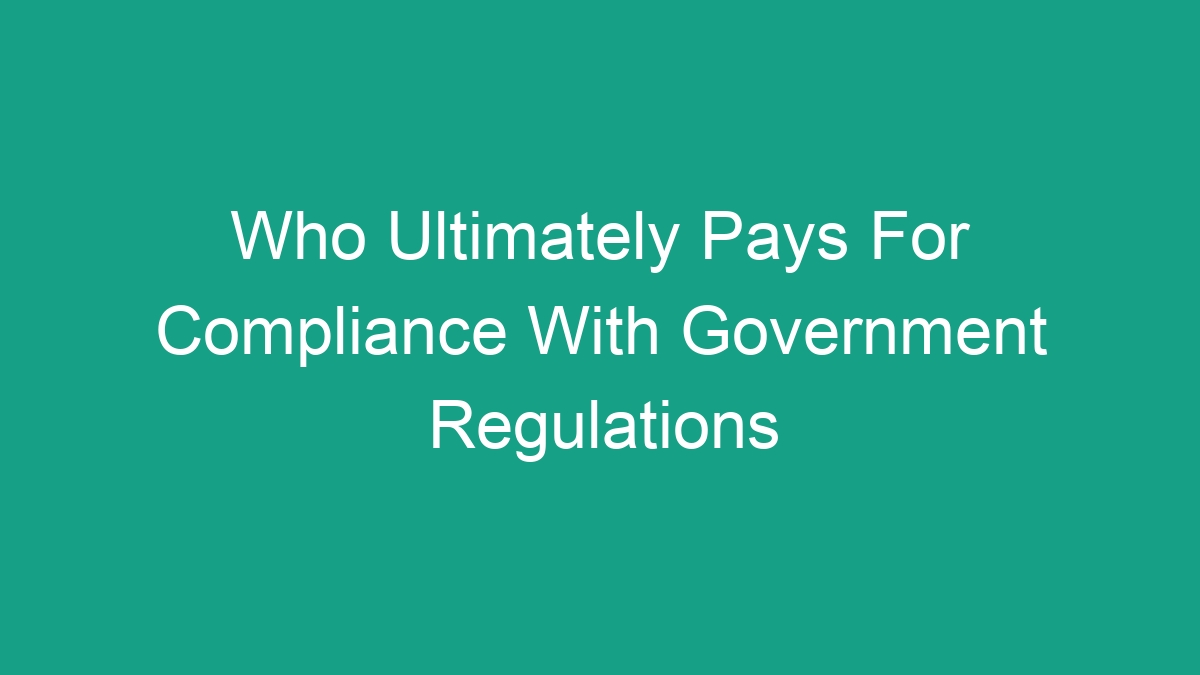
Introduction
In today’s complex business environment, companies are faced with a myriad of government regulations that they must comply with in order to operate legally and ethically. These regulations can come from various levels of government, including federal, state, and local authorities. Compliance with these regulations often comes with a cost, and understanding who ultimately bears this cost is essential for businesses and society as a whole.
The Cost of Compliance
Compliance with government regulations involves ensuring that a company’s operations, products, and services align with the required standards set forth by governing bodies. This can include adhering to labor laws, environmental regulations, safety standards, and financial reporting requirements, among others. Ensuring compliance often requires companies to invest in additional resources, such as personnel, technology, and infrastructure, to meet these standards. These investments can be quite substantial, particularly for smaller businesses with more limited resources.
In addition to the direct costs of compliance, there are also indirect costs associated with navigating the often-complex regulatory landscape. Businesses may need to dedicate significant time and effort to understanding and interpreting regulations, as well as engaging in ongoing monitoring and reporting activities to maintain compliance.
Who Bears the Costs?
The question of who ultimately pays for compliance with government regulations is a complex one, as the costs are often not borne by any single entity alone. Rather, the burden of compliance is distributed among various stakeholders, including businesses, consumers, employees, and, in some cases, the government itself.
Businesses bear the most direct costs of compliance with government regulations. They are responsible for ensuring that their operations and practices are in line with the required standards, and as such, they must invest in the necessary resources to achieve and maintain compliance. These costs can include hiring additional personnel, implementing new technology or infrastructure, and engaging in ongoing monitoring and reporting activities.
Consumers also bear a portion of the cost of compliance through higher prices for goods and services. When businesses incur additional expenses to comply with regulations, they often pass these costs on to consumers in the form of higher prices. While this may be less noticeable for everyday items, the cumulative effect of compliance costs can have a significant impact on the cost of living for individuals and families.
Employees may also feel the impact of compliance costs, particularly if businesses are forced to make cutbacks or changes in response to new regulations. This could manifest as reduced wage increases, lower job creation, or even job losses in some cases.
Finally, the government itself may incur costs related to compliance, particularly in terms of enforcing regulations and overseeing compliance efforts. This can include funding regulatory agencies, conducting inspections, and implementing penalties for non-compliance.
The Impact on Businesses
The costs of compliance with government regulations can have a significant impact on businesses of all sizes. For smaller businesses with limited resources, compliance costs can be particularly burdensome, potentially hindering their ability to grow and innovate. This can create barriers to entry for new businesses and stifle competition within industries.
Compliance costs can also affect a company’s ability to invest in research and development, as well as in workforce training and development. These investments are critical for businesses to remain competitive and adapt to changing market conditions, so any hindrance to these activities can have long-term negative implications for the economy as a whole.
Furthermore, compliance costs can divert resources away from other important business activities, such as customer service, marketing, and product development. This can result in reduced competitiveness and hinder a company’s ability to respond to consumer needs and market trends.
The Broader Societal Impact
The impact of compliance costs is not limited to businesses alone. There can be broader societal implications, as well. The burden of compliance can ultimately affect the cost of living for individuals and families, as higher prices for goods and services can erode purchasing power and reduce overall living standards.
Furthermore, compliance costs can hinder job creation and wage growth if businesses are forced to reallocate resources away from these activities. This can lead to reduced opportunities for employment and economic advancement, particularly for individuals in marginalized communities.
From an environmental standpoint, compliance costs can have both positive and negative impacts. On the one hand, regulations aimed at protecting the environment can lead to higher compliance costs for businesses, which in turn may be passed on to consumers. On the other hand, these regulations can result in cleaner air and water, healthier ecosystems, and reduced public health risks, which can ultimately benefit society as a whole.
Conclusion
In conclusion, compliance with government regulations imposes costs on businesses, consumers, employees, and the government itself. These costs can have wide-ranging implications for the economy and society as a whole, impacting everything from the cost of living to job creation and environmental quality.
Understanding who ultimately pays for compliance with government regulations is crucial for policymakers, businesses, and consumers alike. It requires careful consideration of the distribution of costs and benefits, as well as the potential trade-offs between regulatory objectives and economic outcomes. Finding the right balance is essential to ensure that regulations promote public welfare while also fostering economic growth and innovation.
As the regulatory landscape continues to evolve, it will be important for all stakeholders to engage in open and constructive dialogue to address the challenges and opportunities presented by compliance costs. Only through collaboration and thoughtful policymaking can we strike the right balance between regulatory requirements and economic prosperity.



